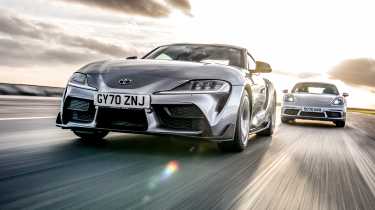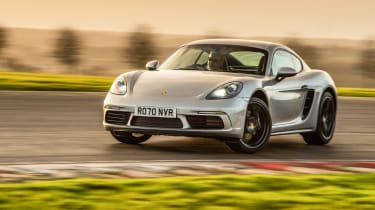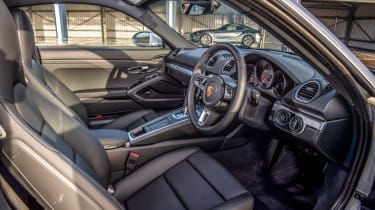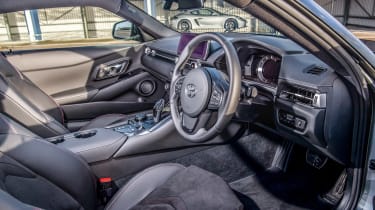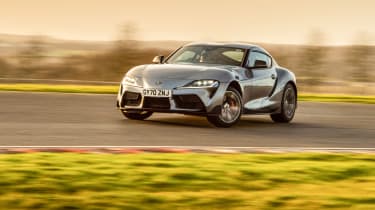Toyota Supra 2.0 v Porsche 718 Cayman – four-cylinder coupes go head-to-head
Supra and Cayman can both be had with 2-litre four-cylinder engines that pack a surprising punch, but which is the sweeter steer? We find out on road and track
On one level, this is a battle of philosophies. In the Toyota you have the classic front-engine/rear-drive coupe, represented here by the Supra in its four-cylinder form, less powerful than the straight-six but lighter and better-balanced, boasting that holy grail 50:50 weight distribution. Then you have the Cayman, also four-cylinder, representing the mid-engined layout and its low polar moment of inertia. Obviously, it’s no happy coincidence that their loans coincide with a booking at the Bedford Autodrome. It’s cold and a bit damp but that’s just fine.
These may be the least potent versions of their ranges but the Supra’s BMW-sourced, turbocharged 2-litre in-line four still pumps out a useful 254bhp and, just as pertinently, an impressive 295lb ft from just 1550rpm. This is fed to a pair of fat 285/40 ZR18 Michelin Pilot Super Sports via an electrically controlled, adaptive limited-slip diff. Sounds like a recipe for exciting on- and over-the-limit adventures.
The Cayman offers even more go. We’ve not been fans of the soundtrack of the 718’s turbocharged flat-four since it was introduced in 2016 (we remember the flat-six so fondly). You can’t deny it’s potent for a 2-litre, though, developing a rude 296bhp and 280lb ft at just over 2000rpm. And while the Supra might need the help of a slippy diff to get its torque to the road, the Cayman can manage without, thanks to the mass of its engine sitting just ahead of its rear wheels.
The large-radius hairpin at the far end of the West Circuit looks inviting in the thin light. If it was on the road it would be large, deserted roundabout, its surface glistening, and as you approached it you’d be stabbing buttons or touchscreens or whatever to disable traction control, intent on a bit of fun.
It’s a surprise, then, to discover that even after you’ve disabled their stability and traction control systems, you have to work pretty hard to get either the Supra or Cayman to power oversteer. Simply turn in carrying speed and you’ll feel the front lose grip and push into understeer. Cue pouty bottom lip. Of course, on the road a bit of front-end slip is useful, a safe indicator that you’re on the limit of grip and that if you use more throttle the rear tyres might lose theirs. That’s exactly what we want here, where we have the space to play and learn, yet it takes a lot of provocation.
The amount of grip the Porsche finds is not surprising. Over the years we’ve learned that Caymans and Boxsters are uncannily grippy in these conditions, as if they’re on super-sticky rain tyres. Still, it’s surprising that even when you’ve successfully upset the Cayman – backing off sharply as you turn in to transfer weight from the rear to the front, and then hitting the throttle –that it quickly runs out of puff and grip reasserts itself. It feels well balanced, every bit as sweetly and confidently poised on opposite lock as the Supra, despite a less ideal weight distribution. It’s also impressively neutral if you bail out of the throttle mid-slide.
This Cayman is fitted with many options, including upsized wheels, the standard (and suspiciously unattractive) 18-inch alloys replaced here by ‘Carrera S’ 20s. The tyre widths remain 235 front and 265 rear, only the aspect ratio changes, dropping from 45 to 35. Things have headed in the opposite direction for the Supra. The 3-litre sits on 19-inch wheels but the 2-litre is on 18s. Tyre widths are unchanged – a generous 255 up front and 285 at the rear – with the side profile increased from 35 to 40. The Toyota puts plenty of tread on the road, then, and, as with the Porsche, you have to work pretty hard to get the tail to kick out. Succeed and it’s quite easy to catch and hold with the help of that active diff but, as with the Porsche, you don’t have an excess of torque and power to let you play with it for too long.
With this knowledge, you feel confident throwing them into the Autodrome’s faster corners at dramatic speeds, knowing that as momentum and power bleed away they’ll come back straight. And they do… as long as you don’t arrive at the apex backwards. Great fun, but it also means that on the road you should be able to relax while you’re pushing them hard because their limits are high and they’re easily handled should you stray over the limit. It’s an underrated satisfaction being able to exploit all of a car’s performance without getting into a fight with it or being held back by continual traction control interventions. But road driving is also much more nuanced than track driving, more centred on feel and feedback, more demanding of accuracy and more in search of character.
The Porsche looks good value compared with the Toyota. It has a list price of £45,230 to the Supra’s £46,010 and is more powerful and quicker. The picture changes slightly if you want an automatic. An eight-speed ZF auto is standard in the Supra – there’s no manual option – while in the Cayman swapping the six-speed manual for the eight-speed PDK is an extra £2k. It takes its kerb weight to 1365kg, closer to the Supra’s 1395kg, but thanks to the PDK’s shift speed also makes it a couple of tenths faster off the line than the manual, hitting 62mph in 4.9sec, the Supra taking 5.2.
The Supra comes with adaptive damping and that LSD, options that can be picked for the Cayman, PASM costing £1010 and the torque-vectoring diff £926, though based on track performance the Cayman doesn’t need the diff. Will it need the damping for the variables of the road? Let’s see.
The only option you can have on the Supra is metallic paint (£710), which this example has, while the options available for the Cayman are extensive and the ticked boxes on this car add up to over £13k, including £632 for metallic paint. However, apart from the PDK gearbox, the only option likely to affect its performance feel are the 20-inch wheels, which cost £2576 once you’ve forked out the extra £842 to have them painted gloss black.
They look much better than the stock 18s, but they’re so big and thin-spoked that they make the disc brakes look tiny and you can see so much gubbins through the rear wheels – brake wiring, heat-shielded exhaust, bits of suspension and more – that it looks like a cut-away for a motor show stand. They do give the Cayman a better stance than the Supra on its 18s, though, and here they are complimented by black detailing and smoked rear light lenses.
Thing is, Caymans are handsome but they’re also quite familiar whereas the Supra is such a rare spot it’s still strikingly new and has some great angles, especially the rear three-quarters where it looks like a scaled-down Dodge Viper GTS. And while the six-cylinder model might have a classier, more alluring engine note, from the outside the in-line four sounds tight and punchy on full throttle. From the inside it’s… curiously ambiguous thanks to augmented sound played through the speakers.
It’s a mystery why the Porsche flat-four has never sounded great when, from the same basic design, Subaru created an off-beat holler as eagerly anticipated on rally stages as the warble of Audi’s in-line five. At idle this Cayman still sounds disappointingly like an air-cooled Beetle, only without the odd whistle. There is good news, though; from the inside it’s obvious things have improved dramatically…
Porsche claims no changes but the 718’s flat-four is now smooth and refined, the engine it should have been at launch. It’s taken five years but it’s clear that Porsche’s powertrain and NVH engineers have been busy. Yes, it’s still Beetle-like at low revs but it’s now much sweeter-sounding and smoother everywhere else, thanks to what feels like a combination of improved engine NVH and better sound deadening. It’s still not an engine you exercise just to hear it sing, but you don’t now wince on a light throttle or when stroking it to the red line.
The Supra’s four feels like it has already undergone a similar isolating and refining process. Give the throttle a good squeeze and it feels like the traditional long-bonnet/short-rump, rear-drive coupe it is. The in-line four scoots it forward on decent low-end torque and delivers everything it’s got in one smooth, consistent sweep of the rev counter, sounding vaguely enthusiastic and feeling a bit remote.
Both these coupes are plenty quick enough to be exciting but they’re also both ridiculously long-geared considering they have eight ratios. The Supra’s overall gearing is slightly shorter than the Cayman’s, which, for no good reason, will take you to more than 70mph in second gear. It will hit 170mph but does it really need six more ratios to get there? The responsive, sweet-shifting PDK should be doing more at cross-country speeds, keeping the engine on the boil, particularly as the Cayman’s throttle response isn’t as sharp as the Supra’s.
The ZF auto in the Supra isn’t quite as snappy, but given that you’ll only trouble the first three gears up to 100mph that’s less concerning than it might sound. Dynamically, the Toyota’s 50:50 weight distribution gives it a willing, agile feel on a good road; it flicks into corners and changes direction willingly. It’s more supple and more approachable than the edgier six-pot Supra 3.0, difficult asphalt disappearing beneath its wheels with less fuss, and you can make impressive progress. The fatter sidewalled tyres seem to usefully slow the steering response, too, which can be a bit jumpy on-centre in the Supra 3.0, though there’s still very little feel to work with. The same goes for the chassis, which offers up lots of grip but mid-corner feels rather rubbery and ill-defined.
Even though it’s the least expensive car it makes, the Cayman still feels very Porsche. There’s plenty of grip, so it can carry speed like the Supra, and although its steering feels a little slow off-centre, by mid-corner when you’re leaning on the grip, it’s right there. There’s not fantastic detail and feel, perhaps a result of the wheel upsizing, but you feel more connected than in the Supra. The ride is sublime right from the off, too: great over roads with patchy repairs and broken edges, even over speed humps, so you don’t feel the need to steer around anything. You put the Cayman where you want it, the suspension deals with whatever is there and the car isn’t deflected from its line.
You can whip the Cayman along at a terrific pace without much effort on your part or, seemingly, the part of the car. It’s all very calm and polished. The weight and quality feel of the shifter in manual mode, the brake pedal, the steering and even the stalks is consistent, measured and assured. It’s the polish of a more expensive and more powerful car. Like the Supra, it’s not alive with feel, and throttle response is a bit lacking too – the flat-four is more revver than lugger – but it’s by far the more capable and rewarding of the two.
The Supra never feels as polished, consistent or considered as the Porsche. In isolation, it’s perfectly habitable and responsive, but you don’t need the Cayman along to point out its dynamic remoteness. The further you drive the Supra the more you realise that while its steering is quick-witted and accurate there’s precious little feel to work with or enjoy. This is especially obvious in the wet when you want to feel the level of grip and be able to sense when it changes.
The chassis falls short in a similar way. Yes, its adaptive damping means that when you press the Sport button you get a better controlled ride (and weightier steering and snappier throttle response) but the chassis of the Cayman with its fixed damping excels over a wider range of challenges and, crucially, provides a greater sense of what’s going on. The Supra has the grip and balance to tackle a series of corners as quickly and securely but the feel through the seat and wheel is much different, the Supra chassis feeling elastic and oddly detached when pressed. You wish it would push back harder.
The Cayman isn’t perfect. You crave a little more steering detail and a little more dynamic interaction, which maybe you get with the standard 18-inch wheels. Also, the flat-four is significantly improved, especially in terms of refinement – and about time, too – but still lacks appealing character. All of that said, overall the 718 Cayman is a great coupe that’s now better than ever. It’s surprisingly practical, has strong performance and delivers superb dynamic reach… and you can have it with a manual gearbox. It’s also shot through with a feeling of solid engineering that’s usually only found in cars costing twice as much. Its popularity is earned.
This story was first feature in evo issue 287.
Specs
| Porsche 718 Cayman (PDK) | Toyota GR Supra 2.0 | |
| Engine | Flat-4-cyl, 1988cc, turbo | In-line 4-cyl, 1998cc, turbo |
| Power | 296bhp @ 6500rpm | 254bhp @ 5000rpm |
| Torque | 280lb ft @ 2150-4500rpm | 295lb ft @ 1550-4400rpm |
| Weight | 1365kg | 1395kg |
| Power-to-weight | 220bhp/ton | 185bhp/ton |
| 0-62mph | 4.9sec | 5.2sec |
| Top speed | 170mph | 155mph |
| Basic price | £47,230 | £46,010 |

